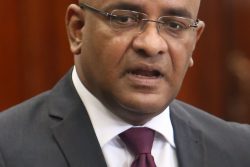Dear Editor,
On July 27, 2018, Guyana signed a Memorandum of Understanding (MOU) supporting China’s Belt and Road Initiative (BRI). The MOU was signed by the then Chinese Ambassador Cui Jainchun and Carl Greenidge, former Foreign Minister, on behalf of the Government of Guyana. At the time of signing the agreement, Greenidge was quoted as saying that ‘he did not rule out the possibility of, securing finance under the BRI for the construction of the new Demerara Harbour Bridge and that seven Chinese companies had submitted tenders to prequalify for the financing, designing and building of the bridge.’ Later, in September of the same year, Chinese State Councillor and Minister of Foreign Affairs Wang Yi made a brief stop-over in Guyana on his way to New York to participate in the 73rd Session of the UN General Assembly. During his brief stop-over, the Chinese minister along with his Guyanese counterpart signed the official agreement on the BRI. The BRI agreement has a three (3) year shelf life with the possibility of a three-year extension
September this year will mark three years since the signing of the agreement, however with a new government in office, the 2018 agreement and the prospect for entering into a new three-year agreement hangs in the balance. More than seventy countries are signatories to the BRI including nine CARICOM countries including Brazil and Venezuela. The latter two should be viewed futuristically as strategic for both China and Guyana. In a declaration issued at the end of a meeting of the CELAC-China Forum held in June 2018 in Santiago, Chile, CARICOM foreign ministers considered the BRI ‘a very important cooperation and development mechanism.’ In October of the same year, Prime Minister Roosevelt Skerrit of Dominica was quoted as saying; “Sometimes in our society we cause ourselves to tag on to unnecessary discussions, and so now there is talk about countries should not engage China, countries should not enter into agreements with China because China is trying to dominate the world and China is trying to advance its influence on the Caribbean. Skerrit went on to say; “Some of us propagate this foolishness. We propagate it because we believe that it is serving our purpose.” What Skerrit said three years ago remains a hot issue to this day in many countries, including Guyana.
During his visit to Guyana in September 2020, former US Secretary of State Mike Pompeo put his cards on the table. In a statement made on local TV he pointed out: “We want to make sure that foreign direct investment comes in a way that’s fair and transparent. We don’t apply political pressure connected to our commercial enterprises. China operates differently, they put pressure on countries to accept tenders from their country. That’s not how American businesses roll. We show up; we hire locally. We are great environmental stewards. We abide by the rule of law. We respect countries’ sovereignty. Those are the things I think nations are looking out for, and I think the new leadership here in Guyana is looking for.” Not surprisingly, the Chinese Embassy in Georgetown shot back; ‘…We advise Mr. Pompeo to stop spreading rumors and fake news everywhere to confuse people. Otherwise, he will end up humiliating himself and damage his own image,’ they said.
In March this year, six Chinese along with three European companies were pre-qualified to tender for the new bridge over the Demerara River. And just recently, on April 29th, the nine pre-qualified nine companies were invited to tender bid documents for either a design, build or finance (DBF) or a design, build, finance, operate and maintain (DBFOM). It is of interest to note that no American company has expressed an interest in the pre-qualification process initiated in September last year. Should one of the six Chinese companies be successful, it is left to be seen whether Guyana will opt to secure financing for construction of the bridge under the BRI, since the 2018 Agreement will still be in force. Coincidentally, Article Two of the 2018 Agreement states: ‘The Parties will cooperate and exchange ideas regarding infrastructure connectivity and development in areas of mutual interest, including but not limited to road and railway networks, bridges, civil aviation, maritime transport, harbours and ports, energy and telecommunications.’
In the meanwhile, the good news is that disagreements between government and China Harbour Engineering Company (CHEC) over the US$150M CJIA expansion project have narrowed considerably. With 90 per cent of outstanding issues resolved, government has expressed optimism that the December 31, 2021 deadline for completion of all outstanding issues will be met by CHEC. This should clear the decks for further Chinese investments in Guyana, boost investor confidence and attract injection of new foreign capital inflows. Of relevance here is government’s recent revision of Guyana’s debt threshold from $400bln to $650bln. According to Ashni Singh, Senior Minister in the Office of the President with responsibility for Finance, “The revision of the debt ceiling will accommodate the prevailing economic reality and assure that investments can be made for the equal level of growth”. Singh emphasized that, “Government needs enough space to secure the external financing necessary to pursue its ambitious programme of development aimed at transforming Guyana and delivering an improved quality of life to all Guyanese.” As a middle-income developing nation and because of the triple impact of oil revenues, climate change and the COVID-19 pandemic, Guyana is likely to experience significant adaptations in its economic, agricultural, health and education sectors as well as in income distribution. Under these conditions, the BRI can be a useful developmental mechanism to help confront the challenges and open new opportunities that lie ahead.
Sincerely,
Clement J. Rohee





